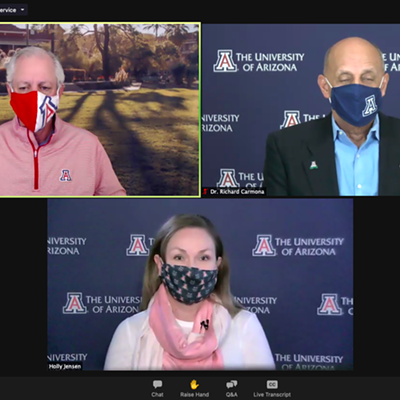Coincidence happens ... sometimes, right there in the crack between your fiction and your fact.
You read about Susan Cummins Miller's fictional geologist/sleuth Frankie MacFarlane feeling an earth tremor, and referring to the 7.4 magnitude Mexican earthquake that unleashed boulders in Tucson-area mountains in 1887—and then you catch the Arizona Daily Star making the same reference in the context of the recent Japanese quake.
Somehow, you think geologist and writer Miller wouldn't call that a coincidence. Unperceived faults, and links, and the cracks between things are what her latest mystery is all about.
Fracture opens with Frankie and love-interest Philo Dain engaging in re-acquaintance activities after Philo's return from Afghanistan. They're interrupted by a call from Philo's long-estranged uncle, asking him to track down a valuable coin collection that his fourth soon-to-be-ex-wife took from him. Although never a favorite of Philo—he had been Philo's cold-hearted guardian after the plane-crash deaths of Philo's parents—Uncle Derek manages to persuade him to go after the collection when the wife shows up murdered. Private-investigator Philo then "hires" Frankie, and they head for Northern California, where fractures familial and geological await them.
Fracture is Tucsonan Susan Cummins Miller's fifth Frankie MacFarlane mystery, and the scientist-turned-author is getting a handle on the genre. Miller—a UA Southwest Institute for Research on Women scholar, and a one-time field geologist for the U.S. Geological Survey—mines the earthquake-prone Bay Area for her setting. The novel is tight and layered—and plot-driven, informed by geology.
The book's action is sparked by the stolen coins and the murdered woman, and it's complicated by mysterious bad guys and Frankie and Philo's discovery in Palo Alto that the larcenous wife is, in fact, alive and kicking. Determining who the dead woman really is, what the significance of the coins is, and who is behind the murder and theft become their objectives.
That all the action takes place in less than a week has Frankie and Philo chugging right along.
In keeping with her geological motif (she even introduces the novel with the definition of "fracture," which includes "a break in a rock ... due to mechanical failure by stress"), Miller structures the work by laying down strata of elements—and some are subject to breakage.
She lightly unifies the work with an ongoing game of chess played by two unexplained characters. Miller's principal point-of-view character is Frankie, but she switches points of view periodically to Philo's nightmares, and to the chess players. Although it takes a moment, readers will catch on to the dream sequences. Miller teases readers with the points of view of the chess players, though, throwing just enough light on them to keep them menacing. One is a powerful guy with a taste for things Greek; the other—eventually called "the man who killed easily and swiftly"—we know less about. She gives clues about their characters (and probably about the action, though this chess-challenged reader missed that) through their game. They're a threat to Frankie and Philo, but they're also somehow threats to each other.
Over the chess motif, Miller layers current events, history, art and geology. She touches on the war in Afghanistan through Philo's secret-op experience there, and then expands that with some unexpected familial ties. History and art come into play when Frankie and Philo discover there's more family treasure than a bunch of old coins to be retrieved. And Miller treats us to her trademark geological field trip: Her descriptions of landscape and seascape are instructive and vivid. The peninsula they drive on—which follows the San Andreas Fault ("the rim of the world")—toward Philo's family compound emerges as a character to be reckoned with in its own right.
With an organization as structured as that of Fracture, the rich story loses a little in flexibility. Some coincidences stretch credibility: for example, art-expert friends who just happen to be in the same area—and happen to be destined to fall in love; and a newly-discovered Afghan half-brother. (Are we there seeing seeds of the sixth Frankie MacFarlane mystery?) They're not major faults, though, and Fracture ends up being entertaining and timely.
Miller has balanced shifting, fragile human relationships on top of shifting, impermanent, massive geological forms. They resonate with each other. They mirror patterns. They share change—that "universal constant" driven by "unseen forces." And they provide a good story.










